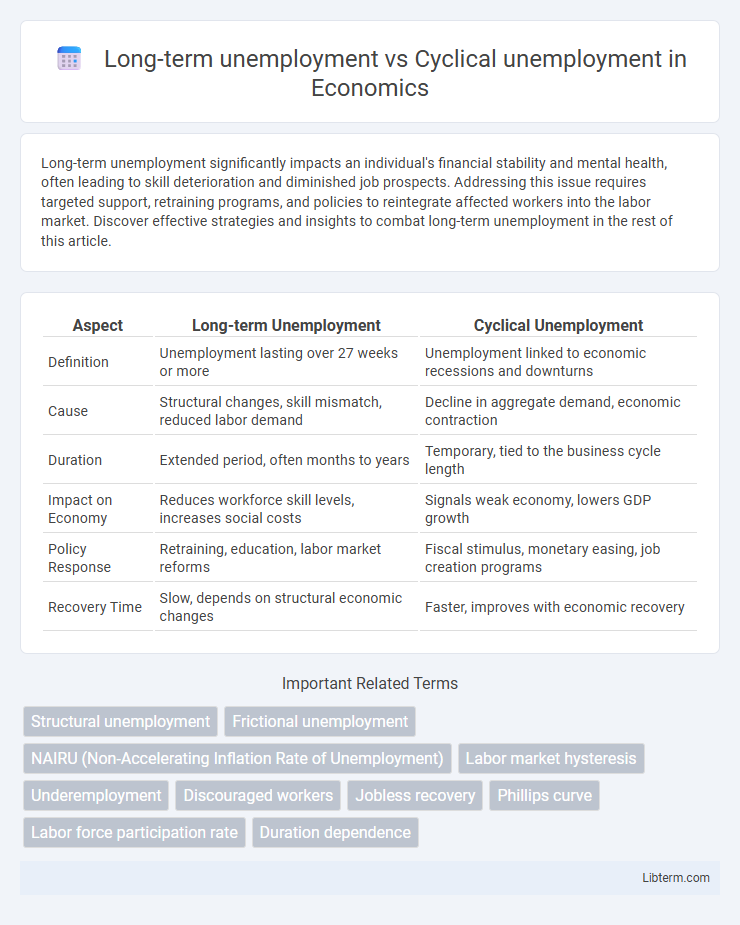Long-term unemployment significantly impacts an individual's financial stability and mental health, often leading to skill deterioration and diminished job prospects. Addressing this issue requires targeted support, retraining programs, and policies to reintegrate affected workers into the labor market. Discover effective strategies and insights to combat long-term unemployment in the rest of this article.
Table of Comparison
| Aspect | Long-term Unemployment | Cyclical Unemployment |
|---|---|---|
| Definition | Unemployment lasting over 27 weeks or more | Unemployment linked to economic recessions and downturns |
| Cause | Structural changes, skill mismatch, reduced labor demand | Decline in aggregate demand, economic contraction |
| Duration | Extended period, often months to years | Temporary, tied to the business cycle length |
| Impact on Economy | Reduces workforce skill levels, increases social costs | Signals weak economy, lowers GDP growth |
| Policy Response | Retraining, education, labor market reforms | Fiscal stimulus, monetary easing, job creation programs |
| Recovery Time | Slow, depends on structural economic changes | Faster, improves with economic recovery |
Understanding Long-term Unemployment
Long-term unemployment occurs when individuals remain jobless for an extended period, often exceeding 27 weeks, and indicates structural issues such as skill mismatches or economic shifts. This form of unemployment is less responsive to short-term economic fluctuations compared to cyclical unemployment, which rises and falls with the business cycle. Addressing long-term unemployment requires targeted retraining programs and policies that stimulate sustainable job creation in evolving industries.
Defining Cyclical Unemployment
Cyclical unemployment arises from fluctuations in the economic cycle, primarily during recessions when overall demand for goods and services declines. Unlike long-term unemployment, which persists due to structural changes or skill mismatches, cyclical unemployment is temporary and directly tied to economic downturns. It typically decreases as the economy recovers and demand for labor increases.
Key Differences Between Long-term and Cyclical Unemployment
Long-term unemployment persists for extended periods, often caused by structural changes in the economy or skill mismatches, while cyclical unemployment fluctuates with the business cycle, rising during recessions and falling in expansions. Long-term unemployment leads to skill erosion and decreased employability, whereas cyclical unemployment is temporary and typically resolves as economic conditions improve. Policymakers target long-term unemployment with retraining programs and structural reforms, while cyclical unemployment is addressed through fiscal stimulus and monetary policy adjustments.
Causes of Long-term Unemployment
Long-term unemployment primarily results from structural changes in the economy, such as technological advancements, shifts in industry demand, and skill mismatches that render certain job seekers less employable over extended periods. Unlike cyclical unemployment, which fluctuates with economic recessions and recoveries, long-term unemployment persists due to barriers like outdated qualifications, geographic immobility, and discrimination. These factors contribute to prolonged joblessness, often requiring targeted retraining programs and labor market interventions to restore employment.
Economic Factors Driving Cyclical Unemployment
Cyclical unemployment is primarily driven by economic downturns, such as recessions, that reduce overall demand for goods and services, leading to widespread job losses across industries. Fluctuations in GDP growth and consumer spending heavily influence cyclical unemployment rates, as reduced business revenues force companies to cut labor costs. Long-term unemployment, however, often arises from structural changes in the economy, skill mismatches, or prolonged economic stagnation, distinguishing it from the more temporary and demand-driven nature of cyclical unemployment.
Social and Economic Impacts of Long-term Unemployment
Long-term unemployment leads to significant social consequences such as increased poverty rates, mental health issues, and social exclusion, which hinder community cohesion and individual well-being. Economically, it results in skill atrophy, reduced labor force participation, and lower consumer spending, exacerbating economic stagnation and widening income inequality. Unlike cyclical unemployment, which fluctuates with economic cycles, long-term unemployment creates structural challenges that require targeted policy interventions to support workforce reintegration and economic resilience.
Effects of Cyclical Unemployment on the Workforce
Cyclical unemployment arises from economic downturns, leading to widespread job losses and decreased consumer spending that stall business growth. This type of unemployment disproportionately affects industries sensitive to economic cycles, causing skill erosion and reduced worker morale over time. Prolonged cyclical unemployment can result in a less adaptable workforce, making recovery and reemployment more challenging when the economy improves.
Policy Solutions for Long-term Unemployment
Effective policy solutions for long-term unemployment prioritize targeted job training programs, wage subsidies, and enhanced unemployment benefits to support re-employment efforts. Governments implement active labor market policies such as personalized job search assistance and vocational retraining to address skill mismatches and labor market detachment. These strategies differ from cyclical unemployment policies that focus on macroeconomic stimulus to boost aggregate demand during economic downturns.
Addressing Cyclical Unemployment Through Economic Interventions
Cyclical unemployment arises from economic downturns and can be mitigated through targeted fiscal and monetary policies designed to stimulate demand and job creation, such as government spending increases and interest rate reductions. Unlike long-term unemployment, which often necessitates retraining and vocational programs, cyclical unemployment responds more rapidly to economic recovery efforts. Effective interventions include stimulus packages and unemployment benefits that support consumer spending and maintain workforce engagement during recessions.
Comparing Recovery Strategies: Long-term vs Cyclical Unemployment
Long-term unemployment recovery strategies emphasize comprehensive retraining programs, skill development initiatives, and targeted job placement services to address structural changes in the labor market. Cyclical unemployment recovery focuses on stimulating economic growth through fiscal and monetary policies, such as government spending and interest rate adjustments, to boost aggregate demand. Effective policy design requires tailoring interventions to the unemployment type, prioritizing labor market flexibility for cyclical unemployment and investing in human capital for long-term unemployment.
Long-term unemployment Infographic

 libterm.com
libterm.com